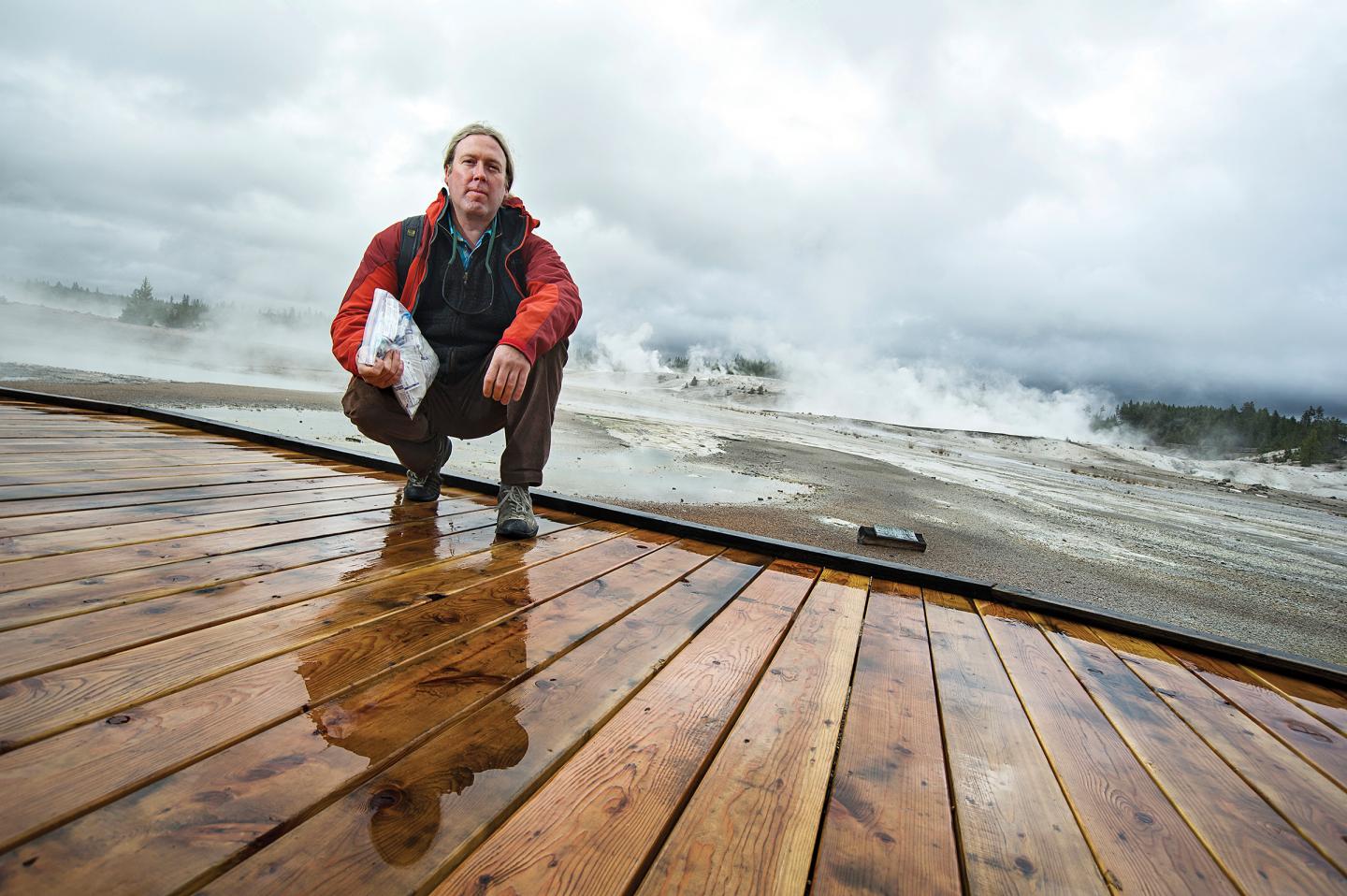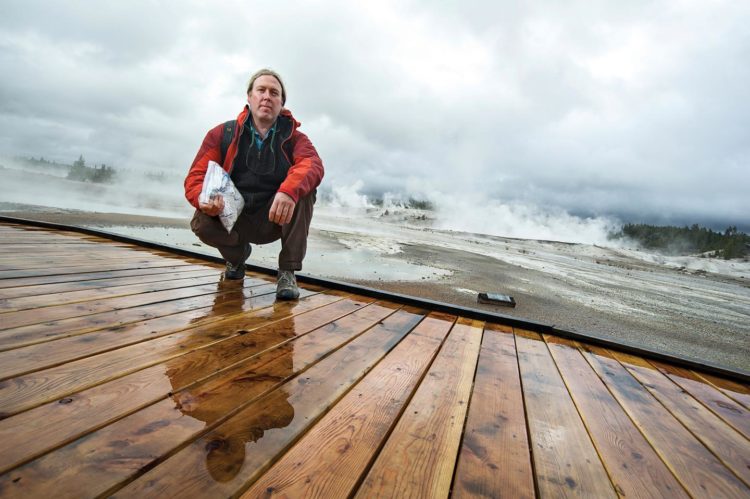
Credit: MSU photo by Kelly Gorham.
BOZEMAN — For over 100 years, scientists have studied the heat-loving microbial life in pools and springs on the surface of Yellowstone National Park.
But what lives below the surface?
A prestigious $1 million grant from the W.M. Keck Foundation will help a team of researchers led by Eric Boyd at Montana State University answer questions about microbial life in the subsurface of Yellowstone, including its extent and processes that allow it to thrive.
“I would be wholly surprised if there wasn’t life down there,” said Boyd, an associate professor in the Department of Microbiology and Immunology in the College of Letters and Science and the College of Agriculture at MSU.
Numerous lines of evidence from surface hot springs have suggested the presence of microbes that eat minerals in hot underground water, but scientists have never isolated those organisms or observed them in their subterranean abodes.
“Every piece of evidence that we and others have collected over the years points to the presence of a subsurface biosphere in Yellowstone,” Boyd said. “The intriguing question then becomes how that life is sustained.”
The Keck grant will support three years of research by Boyd’s interdisciplinary team and fund the design and construction of a specialized instrument triggered by earthquakes to collect samples from deep within existing boreholes. The research will bridge the gap between biology and geology to determine how Earth’s natural processes influence microbial life.
“The research has the potential to significantly impact our understanding of how geological forces drive microbial evolution,” said Mark Jutila, head of MSU’s Department of Microbiology and Immunology. “The efforts of Dr. Boyd and his team in securing this grant are impressive. It is a testament to the impact and recognition of Dr. Boyd’s research and leadership.”
At the surface, life is generally supported by energy from the sun. In the absence of the sun, Boyd explained, microbial life can still flourish with a supply of nutrients such as hydrogen. In rocky environments, such as the Earth’s subsurface, hydrogen can be generated when water reacts with certain minerals. Imagine if you were to drop an iron nail in a glass of water. That nail would rapidly oxidize, forming a thin coat of rust (oxidized iron) and releasing bubbles of hydrogen. However, that coat of rust also protects the metal from further oxidation. Without fresh minerals capable of reacting with water, the potential for how much life can be supported by such nutrients becomes limited. That’s where earthquakes come in.
Earthquakes shear rock and open new fluid flow paths that together expose fresh mineral surfaces to subsurface water that is 100 degrees Celsius or more. Boyd postulates that Yellowstone’s seismic activity is at the heart of the interplay of geologic processes that sustain heat-loving microbes known as thermophiles in the subsurface of Yellowstone. Now his team will try to prove it.
To study this process, the researchers have engineered and fabricated the Kinetically Activated Subsurface Microbial Sampler. This sophisticated unit will be lowered several hundred feet into boreholes that were initially drilled more than a decade ago as part of an unrelated study of North America’s tectonic activity. The sampler synchronizes the collection of subsurface water samples with earthquakes of a specified magnitude, those powerful enough to shear rocks in the subsurface. It is fully autonomous and can collect and preserve six sets of samples before a researcher must visit the site to retrieve them for chemical and biological analysis.
Boyd’s grant proposal integrates hypothesis-driven science with engineering innovation. The new equipment and extreme conditions make the project speculative, but potentially transformative for the field.
“It’s an exciting opportunity,” Boyd said. “One of the things that is neat about the W.M. Keck Foundation is they specifically target research that traditional funding mechanisms wouldn’t normally support. The foundation is geared toward high-risk, high-reward research that leads to paradigm-challenging discoveries that shape the future of scientific discourse.”
The award is made in memory of W.M. Keck’s granddaughter Tammis A. Day of Sula, Montana, a poet, playwright, actress, horsewoman and sister to foundation Chair and CEO Robert Day.
The project will be based at MSU, but includes researchers from Princeton University, the University of Colorado, New Mexico Institute of Mining and Technology, the United Geological Survey, the National Park Service, Salish Kootenai College, Diné College and the private engineering firm Class VI Solutions. Much of the funding will support graduate research positions and summer research internships for undergraduate American Indian students from Salish Kootenai and Diné tribal colleges, a demographic that Boyd said is underrepresented in microbiology research. Summer research internships are aimed at exposing these students to authentic research experiences, with the goal of removing barriers toward their pursuit of an advanced degree in a STEM discipline.
“Keck grants are truly an innovative approach to funding novel, high-risk high-reward research and unique educational opportunities,” Jutila said.
###
Based in Los Angeles, the W. M. Keck Foundation was established in 1954 by the late W. M. Keck, founder of the Superior Oil Company. The foundation’s grant making is focused primarily on pioneering efforts in the areas of medical research and science and engineering. The foundation also maintains a Southern California Grant Program that provides support for the Los Angeles community, with a special emphasis on children and youth. For more information, please visit http://www.
Media Contact
Eric Boyd
[email protected]
406-994-7046
Original Source
https:/





